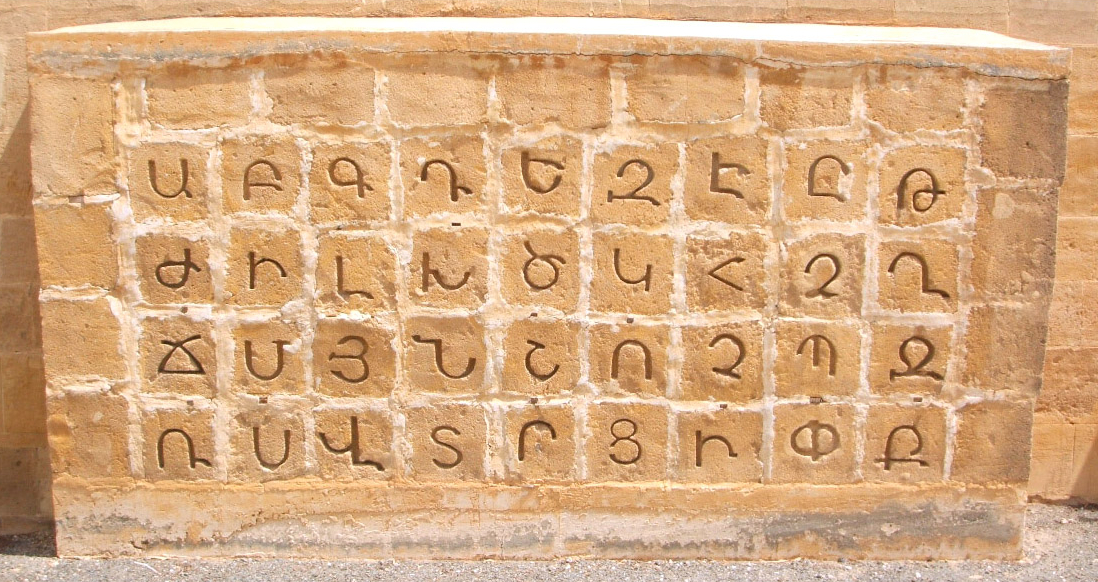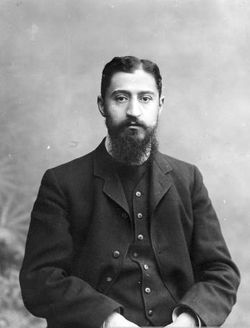|
Matenadaran
The Matenadaran ( hy, Մատենադարան), officially the Mesrop Mashtots Institute of Ancient Manuscripts, is a museum, repository of manuscripts, and a research institute in Yerevan, Armenia. It is the world's largest repository of Armenian manuscripts. It was established in 1959 on the basis of the nationalized collection of the Armenian Church, formerly held at Etchmiadzin. Its collection has gradually expanded since its establishment, mostly from individual donations. One of the most prominent landmarks of Yerevan, it is named after Mesrop Mashtots, the inventor of the Armenian alphabet, whose statue stands in front of the building. Name The word մատենադարան, ''matenadaran'' is a compound composed of մատեան, ''matean'' ("book" or "parchment") and դարան, ''daran'' ("repository"). According to Hrachia Acharian both words are of Middle Persian (Pahlavi) origin. Though it is sometimes translated as "scriptorium" in English, a more accurate translation ... [...More Info...] [...Related Items...] OR: [Wikipedia] [Google] [Baidu] |
Yerevan
Yerevan ( , , hy, Երևան , sometimes spelled Erevan) is the capital and largest city of Armenia and one of the world's oldest continuously inhabited cities. Situated along the Hrazdan River, Yerevan is the administrative, cultural, and industrial center of the country, as its primate city. It has been the capital since 1918, the fourteenth in the history of Armenia and the seventh located in or around the Ararat Plain. The city also serves as the seat of the Araratian Pontifical Diocese, which is the largest diocese of the Armenian Apostolic Church and one of the oldest dioceses in the world. The history of Yerevan dates back to the 8th century BCE, with the founding of the fortress of Erebuni in 782 BCE by King Argishti I of Urartu at the western extreme of the Ararat Plain. Erebuni was "designed as a great administrative and religious centre, a fully royal capital." By the late ancient Armenian Kingdom, new capital cities were established and Yerevan declined i ... [...More Info...] [...Related Items...] OR: [Wikipedia] [Google] [Baidu] |
San Lazzaro Degli Armeni
San Lazzaro degli Armeni (, "Saint Lazarus of the Armenians"; called Saint Lazarus Island in English sources; hy, Սուրբ Ղազար, Surb Ghazar) is a small island in the Venetian Lagoon which has been home to the monastery of the Mekhitarists, an Armenian Catholic congregation, since 1717. It is one of the two primary centers of the congregation, along with the Mekhitarist Monastery of Vienna. The islet lies to the southeast of Venice proper and west of the Lido and covers an area of . Settled in the 9th century, it was a leper colony during the Middle Ages, but fell into disuse by the early 18th century. In 1717 San Lazzaro was ceded by the Republic of Venice to Mkhitar Sebastatsi, an Armenian Catholic monk, who established a monastery with his followers. It has since been the headquarters of the Mekhitarists and, as such, one of the world's prominent centers of Armenian culture and Armenian studies. Numerous important publications, such as the first complete diction ... [...More Info...] [...Related Items...] OR: [Wikipedia] [Google] [Baidu] |
Mark Grigorian
Mark Grigorian ( hy, Մարկ Գրիգորյան, russian: Марк Владимирович Григорян; April 29, 1900 – January 10, 1978) was a Soviet Armenian neoclassical architect. Life Born in Nakhichevan-on-Don, southern Russia, Grigorian moved to Soviet Armenia in 1924. He graduated from the Yerevan State University in 1928 and was appointed as chief architect of Yerevan Yerevan ( , , hy, Երևան , sometimes spelled Erevan) is the capital and largest city of Armenia and one of the world's oldest continuously inhabited cities. Situated along the Hrazdan River, Yerevan is the administrative, cultural, and ... in 1939, succeeding Nikolay Buniatyan. Works Grigorian designed (or co-designed) several major landmarks of Yerevan, including the buildings where the three branches of the government are housed—all on Baghramyan Avenue, and three of the five buildings around Republic Square, along with Eduard Sarapian. Below are listed his most notable wo ... [...More Info...] [...Related Items...] OR: [Wikipedia] [Google] [Baidu] |
Mashtots Avenue
Mashtots Avenue ( hy, Մաշտոցի Պողոտա ''Mashtots'i Poghota''), known as Lenin Avenue until 1990, is an avenue in the central Kentron district of Yerevan, Armenia Armenia (), , group=pron officially the Republic of Armenia,, is a landlocked country in the Armenian Highlands of Western Asia.The UNbr>classification of world regions places Armenia in Western Asia; the CIA World Factbook , , and .... The avenue starts with the Victory Bridge at the south and ends up with the Matenadaran museum to the north. Notable buildings Many prominent buildings in the city of Yerevan are located on the Mashtots Avenue. Below is a list of significant structures located on the avenue (from north to south): * Blue Mosque (1768) * Eduard Isabekyan Gallery (2007) * Yerevan Opera Theater (1933) * Nairi Cinema (1954) * Matenadaran (1959) * President's Residence (1985) * Yerevan State Marionettes Theatre (1987) Gallery File:Ulice Mesropa Maštoce.jpg, Mashtots Avenue f ... [...More Info...] [...Related Items...] OR: [Wikipedia] [Google] [Baidu] |
Arthur Meschian
Arthur (Artashes) Meschian ( hy, Արթուր Մեսչյան; born March 3, 1949) is an Armenian architect, musician, composer, poet, singer and painter. He is also known as one of the founders of Armenian rock. He was the founder and the lead singer of Apostles (1968 – 1979), the first rock band performing songs in their native language in the history of the Soviet Union. He is the author of different architectural projects, including Guest House and the new building of Matenadaran in Armenia. Biography Since childhood, Meschian has been interested in music and arts; singing songs in languages ranging from Hungarian to English. At the age of seven, he started taking violin and piano lessons at the school of music named after A. Spendiaryan. It was during those years when he made his first steps in writing songs and joined the boy's chorus at the National Academic Theater for Opera and Ballet. In 1973, he briefly joined the chorus of the Mother See of Holy Etchmiadzin. Even ... [...More Info...] [...Related Items...] OR: [Wikipedia] [Google] [Baidu] |
Armenian Alphabet
The Armenian alphabet ( hy, Հայոց գրեր, ' or , ') is an alphabetic writing system used to write Armenian. It was developed around 405 AD by Mesrop Mashtots, an Armenian linguist and ecclesiastical leader. The system originally had 36 letters; eventually, three more were adopted. The alphabet was also in wide use in the Ottoman Empire around the 18th and 19th centuries. The Armenian word for "alphabet" is ('), named after the first two letters of the Armenian alphabet: hy, այբ ' and hy, բեն, links=no '. Armenian is written horizontally, left to right. Alphabet *Listen to the pronunciation of the letters in or in . Notes: #Primarily used in classical orthography; after the reform used word-initially and in some compound words. #Except in ով "who" and ովքեր "those (people)" in Eastern Armenian. # Iranian Armenians (who speak a subbranch of Eastern Armenian) pronounce the sound represented by this letter with a retracted tongue body : post-a ... [...More Info...] [...Related Items...] OR: [Wikipedia] [Google] [Baidu] |
Yerevan State University
Yerevan State University (YSU; hy, Երևանի Պետական Համալսարան, ԵՊՀ, ''Yerevani Petakan Hamalsaran''), also simply University of Yerevan, is the oldest continuously operating public university in Armenia. Founded in 1919, it is the largest university in the country. It is thus informally known as Armenia's "mother university" (Մայր ԲՈւՀ, ''Mayr Buh''). Of its 3,150 employees, 1,190 comprise the teaching staff, which includes 25 academicians, 130 professors, 700 docents (associate professors), and 360 assistant lecturers. The university has 400 researchers, 1,350 post-graduate students, and 8,500 undergraduates, including 300 students from abroad. Instruction is in Armenian, but instruction in Russian or English for foreign students is available as needed. The academic year is from September 1 through June 30. According to University Ranking by Academic Performance (URAP), it was the top-ranked university in Armenia and the 954th in the world ... [...More Info...] [...Related Items...] OR: [Wikipedia] [Google] [Baidu] |
Mesrop Mashtots
Mesrob or Mesrop ( hy, Մեսրոպ) is an Armenian given name. Mesrob / Mesrop may refer to: * Mesrop Mashtots, also Saint Mesrop, Armenian monk, theologian and linguist. Inventor of the Armenian alphabet ** Mesrop Mashtots Institute of Ancient Manuscripts, known as Matenadaran, a repository of ancient manuscripts, research institute and museum located in Yerevan, Armenia ** Order of St. Mesrop Mashtots, awarded for significant achievements in Armenia * Mesrob Nishanian of Jerusalem, Armenian Patriarch of Jerusalem from 1939 to 1944 * Mesrob I Naroyan of Constantinople, Armenian Patriarch of Constantinople from 1927 to 1944 * Mesrob II Mutafyan of Constantinople, Armenian Patriarch of Constantinople from 1998 to 2019 See also *Mesropavan Mesropavan (, ) is a historical village in Goghtn Region of Armenia, currently included into Ordubad region of Nakhchivan autonomy of Azerbaijan. Name Mesropavan is named after Mesrop Mashtots, founder of the Armenian Alphabet, who lived in ... [...More Info...] [...Related Items...] OR: [Wikipedia] [Google] [Baidu] |
Kentron District
Kentron ( hy, Կենտրոն վարչական շրջան, translit=Kentron varčakan šrĵan), is one of the 12 districts of Yerevan, the capital of Armenia. It comprises the downtown, the commercial centre of the city. As of the 2011 census, the district has a population of 125,453. Kentron is bordered by Ajapnyak and Malatia-Sebastia districts from the west, Shengavit and Erebuni districts from the south, Nor Nork District from the east and Arabkir and Kanaker-Zeytun districts from the north. Hrazdan River flows through the western part of the district. Etymology The word kentron literally means "centre" in Armenian, and has the same etymological root as the English word, ultimately from Ancient Greek κέντρον (''kéntron'', "centre"). Its Western Armenian cognate is ''getron'' (). Overview The district is unofficially divided into smaller neighborhoods such as Kond, Noragyugh, Pokr Kentron, Nor Kilikia, Kozern and Aygestan. Kond and Noragyugh are among the ... [...More Info...] [...Related Items...] OR: [Wikipedia] [Google] [Baidu] |
Library
A library is a collection of materials, books or media that are accessible for use and not just for display purposes. A library provides physical (hard copies) or digital access (soft copies) materials, and may be a physical location or a virtual space, or both. A library's collection can include printed materials and other physical resources in many formats such as DVD, CD and cassette as well as access to information, music or other content held on bibliographic databases. A library, which may vary widely in size, may be organized for use and maintained by a public body such as a government; an institution such as a school or museum; a corporation; or a private individual. In addition to providing materials, libraries also provide the services of librarians who are trained and experts at finding, selecting, circulating and organizing information and at interpreting information needs, navigating and analyzing very large amounts of information with a variety of resources ... [...More Info...] [...Related Items...] OR: [Wikipedia] [Google] [Baidu] |
International Journal Of Middle East Studies
The ''International Journal of Middle East Studies'' is a scholarly journal published by the Middle East Studies Association of North America (MESA), a learned society. See also * Middle East Research and Information Project * Association for the Study of the Middle East and Africa * '' Middle East Quarterly'' References External links IJMES Editorial Officeat The Graduate Center, CUNY On-line archiveat Cambridge University Press Cambridge University Press is the university press of the University of Cambridge. Granted letters patent by Henry VIII of England, King Henry VIII in 1534, it is the oldest university press in the world. It is also the King's Printer. Cambr ... Middle Eastern studies in the United States Non-Islamic Islam studies literature Quarterly journals Cambridge University Press academic journals English-language journals Middle Eastern studies journals Academic journals associated with learned and professional societies Publications es ... [...More Info...] [...Related Items...] OR: [Wikipedia] [Google] [Baidu] |
.jpg)





